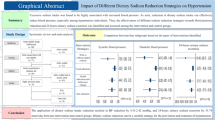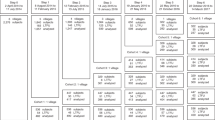Abstract
The present average sodium intakes, approximately 3000–4500 mg/day in various industrialised populations, are very high, that is, 2–3-fold in comparison with the current Dietary Reference Intake (DRI) of 1500 mg. The sodium intakes markedly exceed even the level of 2500 mg, which has been recently given as the maximum level of daily intake that is likely to pose no risk of adverse effects on blood pressure or otherwise. By contrast, the present average potassium, calcium, and magnesium intakes are remarkably lower than the recommended intake levels (DRI). In USA, for example, the average intake of these mineral nutrients is only 35–50% of the recommended intakes. There is convincing evidence, which indicates that this imbalance, that is, the high intake of sodium on one hand and the low intakes of potassium, calcium, and magnesium on the other hand, produce and maintain elevated blood pressure in a big proportion of the population. Decreased intakes of sodium alone, and increased intakes of potassium, calcium, and magnesium each alone decrease elevated blood pressure. A combination of all these factors, that is, decrease of sodium, and increase of potassium, calcium, and magnesium intakes, which are characteristic of the so-called Dietary Approaches to Stop Hypertension diets, has an excellent blood pressure lowering effect. For the prevention and basic treatment of elevated blood pressure, various methods to decrease the intake of sodium and to increase the intakes of potassium, calcium, and magnesium should be comprehensively applied in the communities. The so-called ‘functional food/nutraceutical/food-ceutical’ approach, which corrects the mineral nutrient composition of extensively used processed foods, is likely to be particularly effective in producing immediate beneficial effects. The European Union and various governments should promote the availability and use of such healthier food compositions by tax reductions and other policies, which make the healthier choices cheaper than the conventional ones. They should also introduce and promote the use of tempting nutrition and health claims on the packages of healthier food choices, which have an increased content of potassium, calcium, and/or magnesium and a lowered content of sodium. Such pricing and claim methods would help the consumers to choose healthier food alternatives, and make composition improvements tempting also for the food industry.
This is a preview of subscription content, access via your institution
Access options
Subscribe to this journal
Receive 12 digital issues and online access to articles
$119.00 per year
only $9.92 per issue
Buy this article
- Purchase on Springer Link
- Instant access to full article PDF
Prices may be subject to local taxes which are calculated during checkout




Similar content being viewed by others
References
US Department of Health and Human Services and US Department of Agriculture. Dietary Guidelines for Americans 2005 (www.healthierus.gov/dietaryguidelines).
Karppanen H . Minerals and blood pressure. Ann Med 1991; 2: 299–305.
Guyton AC . Blood pressure control—special role of the kidneys and body fluids. Science 1991; 252: 1813–1816.
Mervaala E . A potassium-, magnesium-, and l-lysine-enriched mineral salt. Cardiovascular and renal effects and interactions with antihypertensive drugs in the rat. Academic Dissertation, University of Helsinki. ISBN 952-90-7197-3 Hakapaino Oy, Helsinki, 1995.
Akita S et al. DASH-Sodium Trial Collaborative Research Group. Effect of the dietary approaches to stop hypertension (DASH) diet on the pressure–natriuresis relationship. Hypertension 2003; 42: 8–13.
Eaton SB, Konner M . Paleolithic nutrition. A consideration of its nature and current implications. N Engl J Med 1985; 312: 283–289.
Eaton SB, Eaton III SB . Paleolithic vs modern diets—selected pathophysiological implications. Eur J Nutr 2000; 39: 67–70.
Appel LJ et al. A clinical trial of the effects of dietary patterns on blood pressure. DASH Collaborative Research Group. N Engl J Med 1997; 336: 1117–1124.
Intersalt Cooperative Research Group. Intersalt: an international study of electrolyte excretion and blood pressure. Results for 24 h urinary sodium and potassium excretion. Br Med J 1988; 298: 319–328.
Law MR, Frost CD, Wald NJ . By how much does dietary salt reduction lower blood pressure? I—Analysis of observational data among populations. Br Med J 1991; 302: 811–815.
Lifton RP, Gharavi AG, Geller DS . Molecular mechanisms of human hypertension. Cell 2001; 104: 545–556.
Kearney PM et al. Global burden of hypertension: analysis of worldwide data. Lancet 2005; 365: 217–223.
He FJ, MacGregor GA . Effect of longer-term modest salt reduction on blood pressure. The Cochrane Database of Systematic Reviews 2004 Issue 1. Art. No.: CD004937. DOI:10.1002/14651858.CD004937.
Sacks FM, et al. For the DASH Collaborative Research Group. Effects on blood pressure of reduced dietary sodium and the dietary approaches to stop hypertension (DASH) diet. N Engl J Med 2001; 334: 3–10.
He FJ, MacGregor GA . Effect of modest salt reduction on blood pressure: a meta-analysis of randomized trials. Implications for public health. J Hum Hypertens 2002; 16: 761–770.
Geleijnse JM, Kok FJ, Grobbee DE . Blood pressure response to changes in sodium and potassium intake: a metaregression analysis of randomized trials. J Hum Hypertens 2003; 17: 471–480.
Whelton PK et al. Effects of oral potassium on blood pressure. Meta-analysis of randomized controlled clinical trials. JAMA 1997; 27: 1624–1632.
Vaskonen T . Dietary minerals and modification of cardiovascular risk factors. J Nutr Biochem 2003; 14: 492–506.
Griffith LE et al. The influence of dietary and nondietary calcium supplementation on blood pressure: an updated meta-analysis of randomized controlled trials. Am J Hypertens 1999; 1: 84–92.
Jee SH et al. The effect of magnesium supplementation on blood pressure: a meta-analysis of randomized clinical trials. Am J Hypertens 2002; 15: 691–696.
Altura BM, Altura BT . Role of magnesium in the pathogenesis of hypertension updated: relationship to its action on cardiac, vascular smooth muscle, and endothelial cells. In: Laragh J, Brenner BM (eds). Hypertension: Pathophysiology, Diagnosis, and Management, 2nd edn. Raven press: New York, 1995, pp 1213–1242.
He FJ, MacGregor GA . Fortnightly review: beneficial effects of potassium. Br Med J 2001; 32: 497–501.
Karppanen H et al. Safety and effects of potassium- and magnesium-containing low sodium salt mixtures. J Cardiovasc Pharmacol 1984; 6 (Suppl 1): S236–S243.
Karppanen H, Vaskonen T, Mervaala E . Novel ‘MultiBene’ food composition lowers serum cholesterol and decreases obesity. XIII International Symposium on Drugs Affecting Lipid Metabolism, Florence 1998 Abstract Book, p. 32.
Vaskonen T, Mervaala E, Krogerus L, Karppanen H . Supplementation of plant sterols and minerals benefits obese Zucker rats fed an atherogenic diet. J Nutr 2002; 132: 231–237.
Saris NE et al. Magnesium. An update on physiological, clinical and analytical aspects. Clin Chim Acta 2000; 29: 1–26.
Mervaala EMA, Laakso J, Vapaatalo H, Karppanen H . Improvement of cardiovascular effects of metoprolol by replacement of common salt with a potassium- and magnesium-enriched salt alternative. Br J Pharmacol 1994; 112: 640–648.
Cappuccio FP . Dietary prevention of osteoporosis: are we ignoring the evidence? J Clin Nutr 1996; 63: 787–788.
Mervaala EMA et al. Beneficial effects of a potassium- and magnesium-enriched salt alternative. Hypertension 1992; 19: 535–540.
Jula A, Karanko H . Effects on left ventricular hypertrophy of long-term nonpharmacological treatment with sodium restriction in mild-to-moderate essential hypertension. Circulation 1994; 89: 1023–1031.
Kupari M, Koskinen P, Virolainen J . Correlates of left ventricular mass in a population sample aged 36 to 37 years. Focus on lifestyle and salt intake. Circulation 1994; 89: 1041–1050.
Eaton SB, Eaton III SB, Konner MJ . Paleolithic nutrition revisited: a twelve-year retrospective on its nature and implications. Eur J Clin Nutr 1997; 51: 207–216.
Karppanen H, Mervaala E . Adherence to and population impact of non-pharmacological and pharmacological antihypertensive therapy. J Hum Hypertens 1996; 10 (Suppl 1): S57–S61.
Vartiainen E et al. Changes in risk factors explain changes in mortality from ischaemic heart disease in Finland. Br Med J 1994; 309: 23–27.
Vartiainen E, Sarti C, Tuomilehto J, Kuulasmaa K . Do changes in cardiovascular risk factors explain changes in mortality from stroke in Finland? Br Med J 1995; 310: 901–904.
National Public Health Institute, Finland. Statistics on cardiovascular diseases 2003.
Tuomilehto J et al. Urinary sodium excretion and cardiovascular mortality in Finland: a prospective study. Lancet 2001; 357: 848–851.
Jürgens G, Graudal NA . Effects of low sodium diet versus high sodium diet on blood pressure, renin, aldosterone, catecholamines, cholesterols, and triglyceride. The Cochrane Database of Systematic Reviews 2004, Issue 1. Art. No.: CD004022. DOI: 10.1002/14651858.CD004022.pub2.
Geleijnse JM et al. Reduction in blood pressure with a low sodium, high potassium, high magnesium salt in older subjects with mild to moderate hypertension. Br Med J 1994; 309: 436–440.
Tikkanen MJ et al. Effect of diet based on low-fat foods enriched with nonesterified plant sterols and mineral nutrients on serum cholesterol. Am J Cardiol 2001; 88: 1157–1162.
Acknowledgements
This work was commissioned by the Factors Affecting Hypertension Task Force of the European branch of the International Life Sciences Institute (ILSI Europe). At the time of the workshop, industry members of this task force were Frito Lay, Kellog, RHM Technology, Unilever and Valio. Further information about ILSI Europe can be obtained through info@ilsieurope.be or tel. +32 (0) 2 771 0014.
Author information
Authors and Affiliations
Corresponding author
Rights and permissions
About this article
Cite this article
Karppanen, H., Karppanen, P. & Mervaala, E. Why and how to implement sodium, potassium, calcium, and magnesium changes in food items and diets?. J Hum Hypertens 19 (Suppl 3), S10–S19 (2005). https://doi.org/10.1038/sj.jhh.1001955
Published:
Issue Date:
DOI: https://doi.org/10.1038/sj.jhh.1001955
Keywords
This article is cited by
-
Advances in the Elemental Composition Analysis of Propolis Samples from Different Regions of Turkey by X-Ray Fluorescence Spectrometry
Biological Trace Element Research (2023)
-
The flavor and acceptability of six different potassium-enriched (sodium reduced) iodized salts: a single-blind, randomized, crossover design
Clinical Hypertension (2016)
-
Dietary contributors to hypertension in adults reviewed
Irish Journal of Medical Science (1971 -) (2015)
-
The Relationship Among Hypertension, Antihypertensive Medications, and Osteoporosis: A Narrative Review
Calcified Tissue International (2013)



